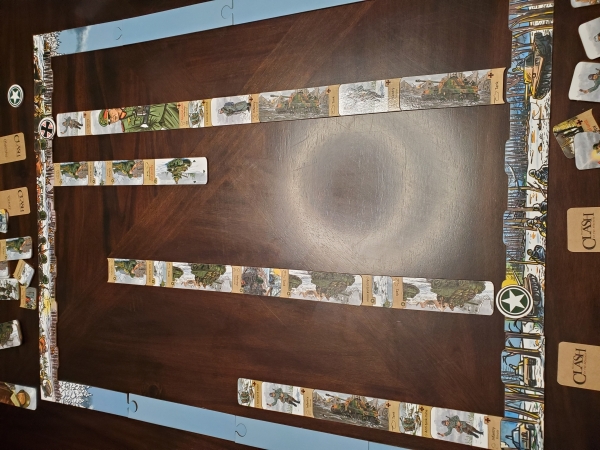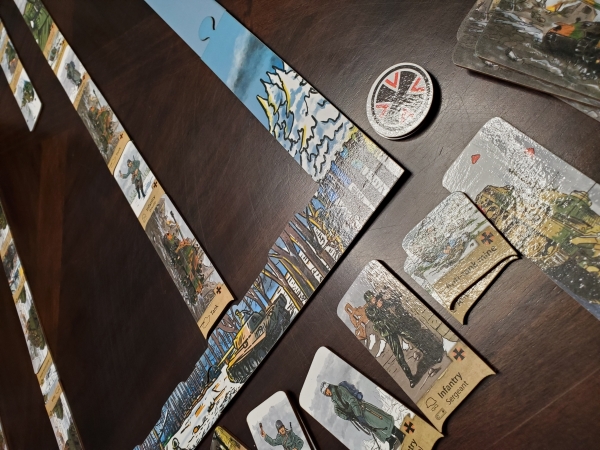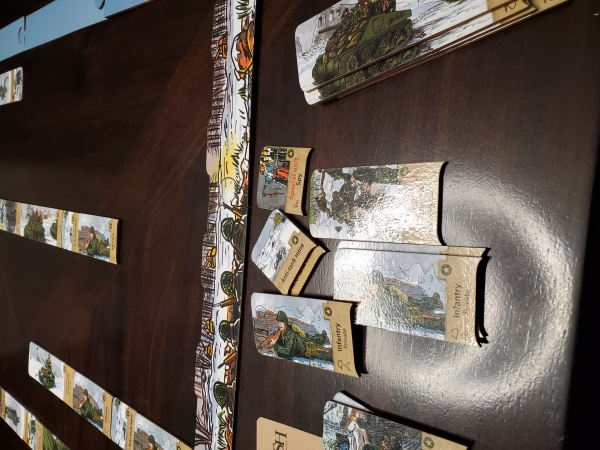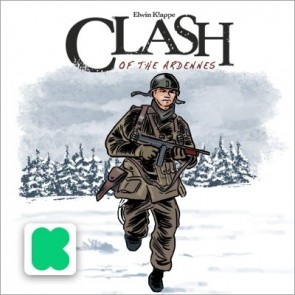A relatively novel idea with an overused setting that can't escape the seemingly rote gameplay.
In the genre of historical wargames, one of the most frequent locales/eras is that of World War II. Along with the most widely-known example of Axis and Allies, one can't look at the wargame genre in general without seeing that conflict in a multiplicity of forms; from Avalon Hill's old hex-and-counter approach to Triumph and Tragedy's card-driven format to Memoir '44's Battlelore-style mechanics and even to one of the latest recent hits, Undaunted, a straight card game. So, when I was approached to review an advance copy of Clash of the Ardennes, I confess to being a little underwhelmed at the setting for the game. Here was yet another depiction of the war, even if the approach was somewhat novel. But it's that novel approach that intrigued me enough to agree to sit down and play it several times to see if there was something there that could elevate it past its source material. My conclusions are mixed.

Clash is a 2-player game between German and American forces during the Battle of the Bulge on the Western Front in 1944. The fight through the Ardennes forest was complex and tested the then-limits of maneuver and logistical strategies. Clash has decided to represent that not with cards or pawns or cardboard tokens glutted with information, but instead with a board made of an empty framework of puzzle pieces and units represented by slats, for lack of a better word, displaying the unit's type and its "reach" into the battlefield situation. Each player takes turns using action points to either place their units in the field in prescribed columns or "streets" or to move already placed units back to their supply or to move them up and down those streets. The object is to be the first to conquer three streets by reaching your opponent's side of the board.
The units are multiple ranks of infantry, tanks, and anti-tank mines that, when contact is made with the enemy, defeat each other in a rock-paper-scissors style (tanks > infantry > mines > tanks) with different ranks of infantry defeating the lower-ranked ahead of them, as well. Thus, the game isn't concerned with stats of any kind or die rolls or active card draws or other types of RNG. Except for the random Objective cards drawn by each player during setup that stipulate exactly what set of streets are to be conquered and the random Victory card drawn for conquering a street, there is perfect information. You can always see what your opponent is doing at any given time, which gives the game more of an abstract feel (like chess) than most other WW2 games. That's to its credit, in that the game will be far more about matching wits with one's opponent than what they happened to draw or roll during play. There are also several "special" units (General, Spy, Command Tank, Mortar) that have special abilities that often allow them to exert their influence over neighboring streets, so that the contest is not strictly (and almost literally) linear. The proper use of said units can often be a key moment in any given game, as one would expect when something like a general or command tank is brought into an actual engagement in the field.

But only one of those special units can be on the table for each player at any time and, if they're part of a squad that conquers a street, they're then frozen to the table until the end of the game. In essence, you use a special unit once to achieve 1/3 of your overall goal and that's it for the day. And that's where the problems with the design are highlighted. Clash isn't an abstract, with broad strategies that create enormous depth in variation and approach; again like chess or Go. It's more detailed than that and, thus, has more specifics to remember in terms of when to place what units and where. But a game that employs that detail encourages one to take advantage of it and, too often in our plays, we found that without the special units, many of our contests became an exercise in tit-for-tat; surging back and forth across the table as whole rows of the enemy were removed and replaced by friendly units only for those units to be removed and so on. The special units made for more interesting tactical maneuvers, but said maneuvers could only take place once per game. Then you were back to the tit-for-tat for the rest of the encounter, which grew tiresome.
The variability created by the different ranks of infantry alleviated that somewhat and the varying objectives brought us into the game with the idea that a different strategy would lead to different gameplay and results, but too often that wasn't really the case and we'd find ourselves bogged down in the hedge country, as it were (that's a Western Front joke), placing the same units over and over as we tried to hurry up and finish our goal before the opposition; if not entirely to win the game so much as to simply get through it. We didn't find ourselves reminiscing after the game about the narrative of what had taken place, as is often the case with games that aspire to tell a story. There was no "Remember when you placed that Spy and it wiped out half of Street #5?" Most abstract games outside of high level play don't often tell stories, either, and that may again be indicative of where this game aspires to do something more than an abstract in a narrative sense, but doesn't quite accomplish it because the gameplay is neither deep nor interesting enough.

In that narrative sense, I understand the desire to limit the use of special units since, after all, how many generals or command tanks are you going to have in any given battle? Furthermore, the Victory card abilities can be transformative, such as the one that allows you to play a second special unit or the one that allows your Corporals to defeat the Spy (the deus ex machina unit of the game that can defeat any opposition.) But they can also compound the limitations of the game, such as the one that denies your opponent's Command Tank its key ability (flanking the enemy.) In a game where unit abilities are already fairly restrained, do you really want to deny them entirely? Again, the restraint is admirable for trying to keep the game within its seeming confines. The time suggested on the box is one hour, which seems reasonable. Our major difficulty was in playing for about half an hour and then really kind of wanting it to be over, since we were in that rut of repetition again.
Now, certainly, games that aspire to depth in play are often less exciting for beginners than they are for more experienced players and that certainly may be the case here. More savvy players might be able to avoid the aforementioned rut and proceed to a stage where the gameplay is actually interesting. But that's what I usually refer to as the Root Problem. How many games are you willing to play that aren't enjoyable until you get to the stage where it is? Root typically solves that problem with an original theme and presentation and wildly asymmetric mechanics. Clash of the Ardennes, unfortunately, does not have those advantages, despite the initial draw of mystery presented by the components, and is weighted with the challenges of an overused setting, as well.
A preview copy was provided by the publisher. Clash of the Ardennes is currently on Kickstarter.
 Games
Games How to resolve AdBlock issue?
How to resolve AdBlock issue? 




















